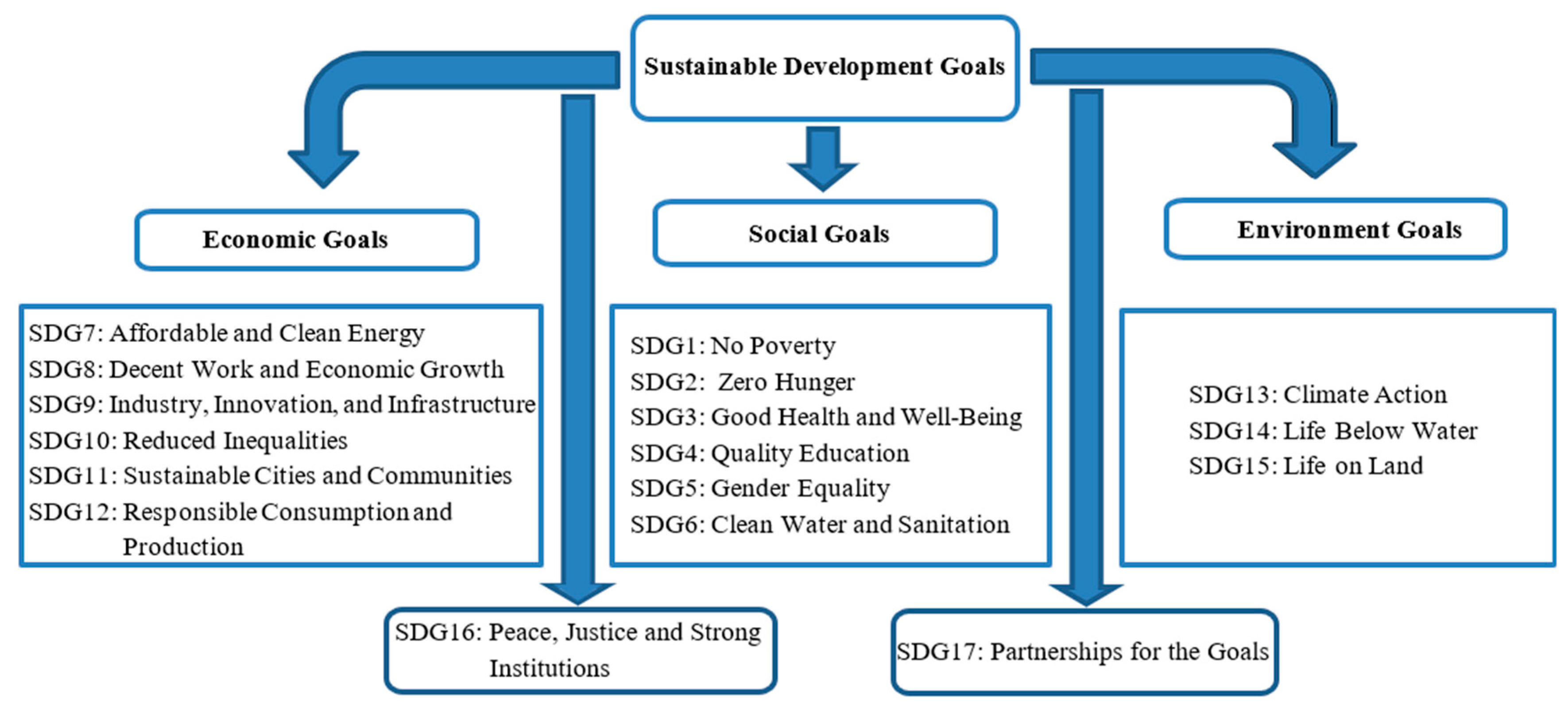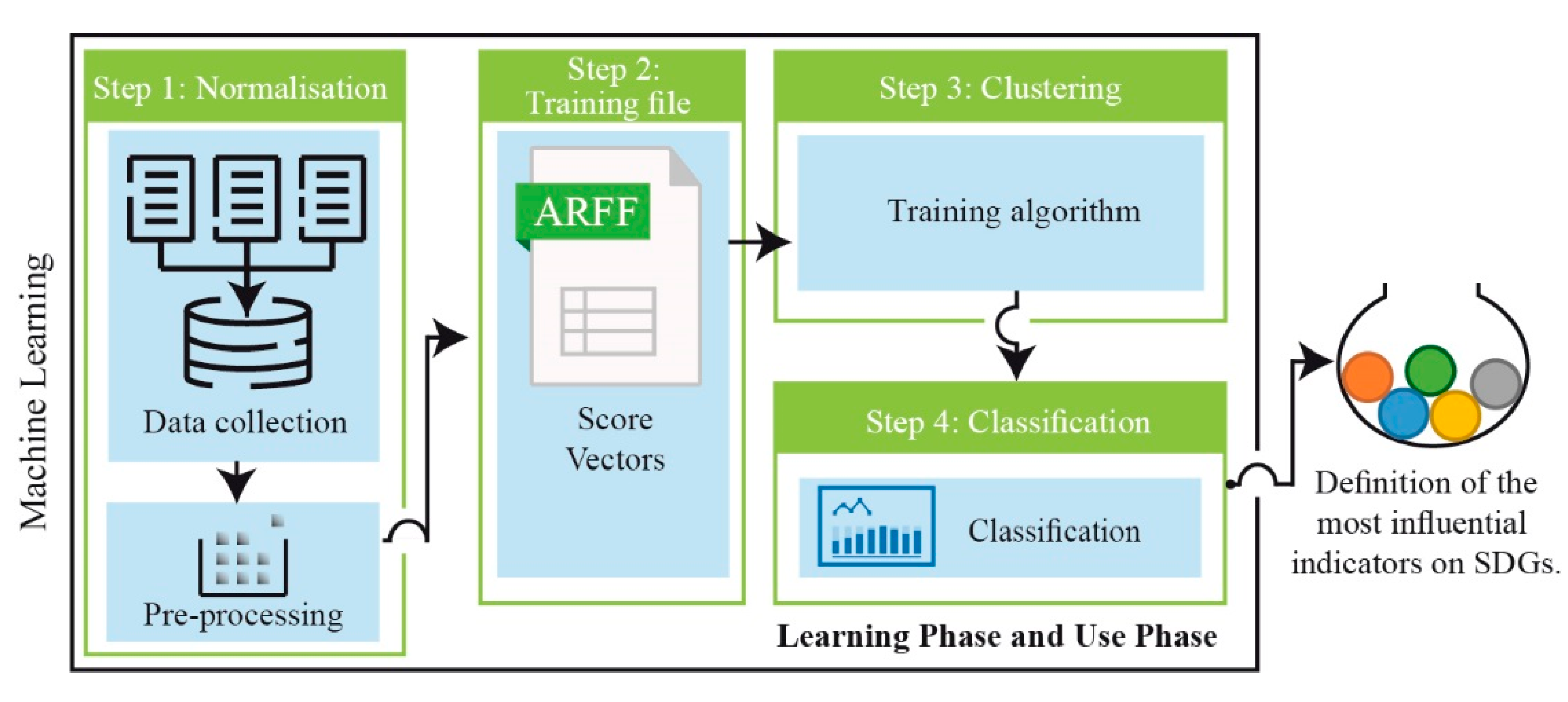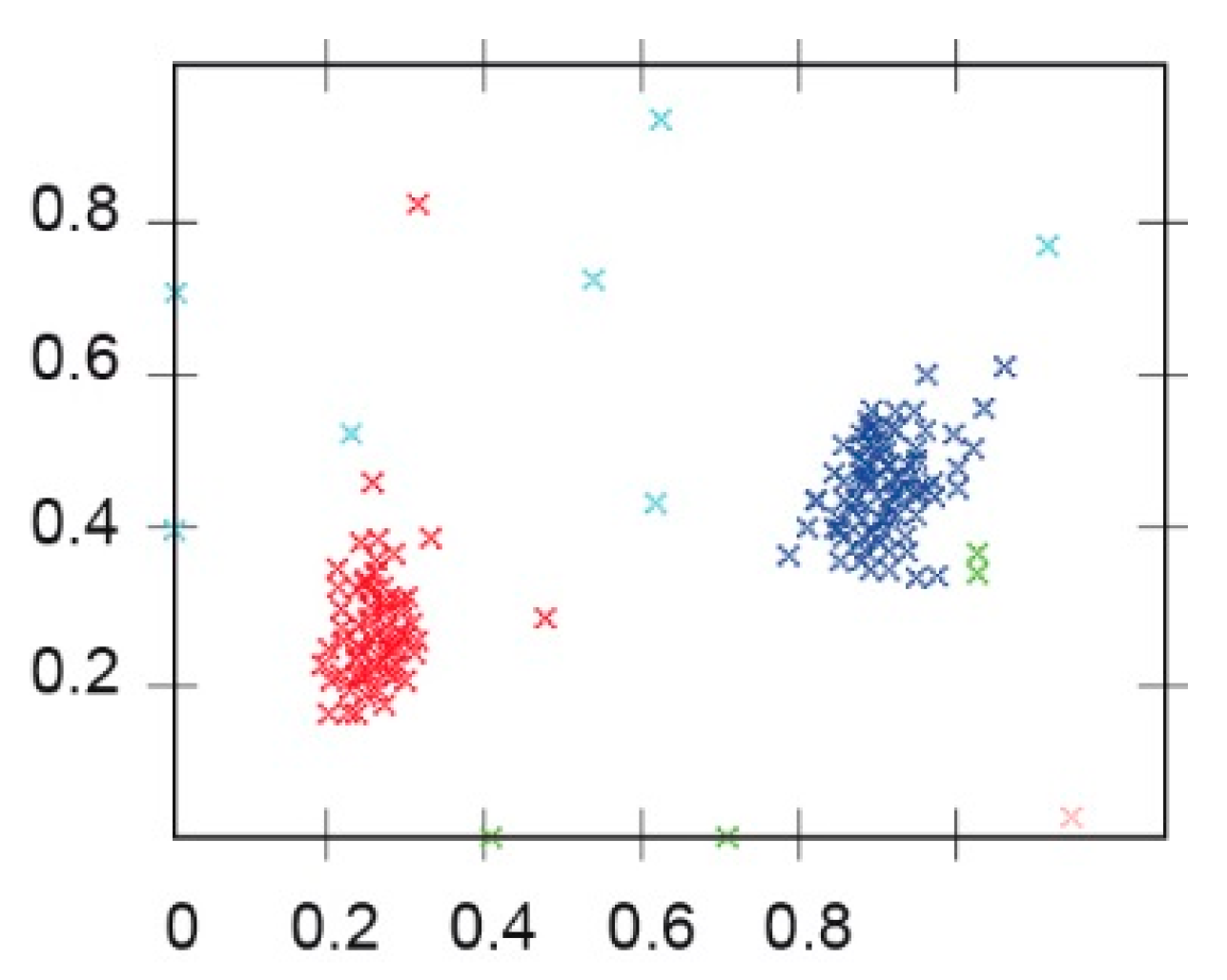The Impact of Digitization to Ensure Competitiveness of the Ha’il Region to Achieve Sustainable Development Goals
Abstract
1. Introduction
2. Data and Methodology
2.1. Overview of the Ha’il Region
2.2. Proposed Method for Reveal of the Main Indicators
2.3. Model Specification
- : is the column vector of the K-dimensional endogenous variable (;
- is the column vector of the d-dimensional exogenous variable ;
- P: is the lag intervals for exogenous variables;
- t: is the number of samples K*d dimension;
- : is the matrix;,……;
- : is the matrix to be estimated;
- : is the K-dimensional perturbed column vector [40].
3. Results and Discussion
4. Conclusions and Recommendations
Author Contributions
Funding
Data Availability Statement
Conflicts of Interest
References
- Gupta, S.; Langhans, S.D.; Domisch, S.; Fuso-Nerini, F.; Felländer, A.; Battaglini, M.; Tegmark, M.; Vinuesa, R. Assessing whether artificial intelligence is an enabler or an inhibitor of sustainability at indicator level. Transp. Eng. 2021, 4, 100064. [Google Scholar] [CrossRef]
- Filho, W.L.; Yang, P.; Eustachio, J.H.P.P.; Azul, A.M.; Gellers, J.C.; Gielczyk, A.; Dinis, M.A.P.; Kozlova, V. Deploying digitalisation and artificial intelligence in sustainable development research. Environ. Dev. Sustain. 2022. [Google Scholar] [CrossRef]
- Del Río Castro, G.; Fernández, M.C.G.; Colsa, U. Unleashing the convergence amid digitalization and sustainability towards pursuing the Sustainable Development Goals (SDGs): A holistic review. J. Clean. Prod. 2021, 280, 122204. [Google Scholar] [CrossRef]
- Martinez, F. Process excellence the key for digitalization. Bus. Process Manag. J. 2019, 25, 1716–1733. [Google Scholar] [CrossRef]
- Ávila-Gutiérrez, M.J.; Suarez-Fernandez de Miranda, S.; Aguayo-González, F. Occupational Safety and Health 5.0—A Model for Multilevel Strategic Deployment Aligned with the Sustainable Development Goals of Agenda 2030. Sustainability 2022, 14, 11. [Google Scholar] [CrossRef]
- Ha, L.T. Are digital business and digital public services a driver for better energy security? Evidence from a European sample. Environ. Sci. Pollut. Res. 2022, 29, 27232–27256. [Google Scholar] [CrossRef]
- Sovacool, B.K.; Upham, P.; Monyei, C.G. The “whole systems” energy sustainability of digitalization: Humanizing the community risks and benefits of Nordic datacenter development. Energy Res. Soc. Sci. 2022, 88, 102493. [Google Scholar] [CrossRef]
- Hadjikhani, A.I.; Lindh, C. Digital love—Inviting doubt into the relationship: The duality of digitalization effects on business relationships. J. Bus. Ind. Mark. 2020, 36, 1729–1739. [Google Scholar] [CrossRef]
- Knudsen, E.S.; Lien, L.B.; Timmermans, B.; Belik, I.; Pandey, S. Stability in turbulent times? The effect of digitalization on the sustainability of competitive advantage. J. Bus. Res. 2021, 128, 360–369. [Google Scholar] [CrossRef]
- Reyers, B.; Selig, E.R. Global targets that reveal the social–ecological interdependencies of sustainable development. Nat. Ecol. Evol. 2020, 4, 1011–1019. [Google Scholar] [CrossRef]
- Bengo, I.; Boni, L.; Sancino, A. EU financial regulations and social impact measurement practices: A comprehensive framework on finance for sustainable development. Corp. Soc. Responsib. Environ. Manag. 2022, 29, 809–819. [Google Scholar] [CrossRef]
- Kottmeyer, B. Digitisation and Sustainable Development: The Opportunities and Risks of Using Digital Technologies for the Implementation of a Circular Economy. J. Entrep. Innov. Emerg. Econ. 2021, 7, 17–23. [Google Scholar] [CrossRef]
- Sachs, J.D.; Schmidt-Traub, G.; Mazzucato, M.; Messner, D.; Nakicenovic, N.; Rockström, J. Six Transformations to achieve the Sustainable Development Goals. Nat. Sustain. 2019, 2, 805–814. [Google Scholar] [CrossRef]
- Yang, W.; Chen, Q.; Guo, Q.; Huang, X. Towards Sustainable Development: How Digitalization, Technological Innovation, and Green Economic Development Interact with Each Other. Int. J. Environ. Res. Public Health 2022, 19, 12273. [Google Scholar] [CrossRef] [PubMed]
- Lichtenthaler, U. Digitainability: The Combined Effects of the Megatrends Digitalization and Sustainability. J. Innov. Manag. 2021, 9, 64–80. [Google Scholar] [CrossRef]
- Burinskiene, A.; Seržante, M. Digitalization as the Indicator of the Evidence of Sustainability in the European Union. Sustainability 2022, 14, 8371. [Google Scholar] [CrossRef]
- Jovanović, M.; Dlačić, J.; Okanović, M. Digitalization and society’s sustainable development—Measures and implications. J. Econ. Bus. 2018, 36, 905–928. [Google Scholar]
- Mondejar, M.E.; Avtar, R.; Diaz, H.L.B.; Dubey, R.K.; Esteban, J.; Gómez-Morales, A.; Hallam, B.; Mbungu, N.T.; Okolo, C.C.; Prasad, K.A.; et al. Digitalization to achieve sustainable development goals: Steps towards a Smart Green Planet. Sci. Total Environ. 2021, 79, 148539. [Google Scholar] [CrossRef]
- Velden, M.V.D. Digitalisation and UN sustainable development goals: What role for design. Interact. Des. Archit. J. 2018, 37, 160–174. [Google Scholar] [CrossRef]
- Holzinger, A.; Malle, B.; Saranti, A.; Pfeifer, B. Towards multi-modal causability with Graph Neural Networks enabling information fusion for explainable AI. Inf. Fusion 2021, 71, 28–37. [Google Scholar] [CrossRef]
- Borowski, P.F.; Patuk, I. Environmental, social and economic factors in sustainable development with food, energy and eco-space aspect security. Present. Environ. Sustain. Dev. 2021, 15, 153–169. [Google Scholar] [CrossRef]
- Bieser, C.T.; Hilty, L.M. Assessing Indirect Environmental Effects of Information and Communication Technology (ICT): A Systematic Literature Review. Sustainability 2018, 10, 2662. [Google Scholar] [CrossRef]
- Cioffi, R.; Travaglioni, M.; Piscitelli, G.; Petrillo, A.; Felice, F.D. Artificial Intelligence and Machine Learning Applications in Smart Production: Progress, Trends, and Directions. Sustainability 2020, 12, 492. [Google Scholar] [CrossRef]
- Neffati, M.; Gouider, A. Socioeconomic Impacts of Digitisation in Saudi Arabia. Int. J. Econ. Financ. Issues 2019, 9, 65–72. [Google Scholar] [CrossRef]
- Kunkel, S.; Tyfiled, D. Digitalisation, sustainable industrialisation and digital rebound—Asking the right questions for a strategic research agenda. Energy Res. Soc. Sci. 2021, 82, 102295. [Google Scholar] [CrossRef]
- Tulchynska, S.; Olha, P.; Garafonova, O.; Yaroshenko, I.; Semyhulina, I. Modeling the influence of innovative factors on sustainable development of regions in the context of digitalization. J. Manag. Inf. Decis. Sci. 2021, 24, 1–8. [Google Scholar]
- Garkushenko, M. Institute of Industrial Economics of the NAS of Ukraine System-dynamic model for assessing the digitalization impact on sustainable development. Econ. Ind. 2021, 1, 20–45. [Google Scholar] [CrossRef]
- Popescu, L.; Lancu, A.; Avram, M.; Avram, D.; Popescu, V. The Role of Managerial Skills in the Sustainable Development of SMEs in Mehedinti County, Romania. Sustainability 2020, 12, 1119. [Google Scholar] [CrossRef]
- Latoszek, E. Fostering sustainable development through the European Digital Single Market. Econ. Bus. Rev. 2021, 7, 68–89. [Google Scholar] [CrossRef]
- Kushnir, A.M.; Dianova, T.V.; Rudakova, E.N. The Contradiction of the Sustainable Development of the Modern Economy in the Conditions of Digitalization: Flexibility and Innovation versus Security and Stability. In Sustainable Development of Modern Digital Economy: Perspectives from Russian Experiences; Springer International Publishing: Berlin/Heidelberg, Germany, 2021; pp. 13–21. [Google Scholar] [CrossRef]
- Farooq, M.; Hussain, A.; Masood, T.; Habib, M. Supply Chain Operations Management in Pandemics: A State-of-the-Art Review Inspired by COVID-19. Sustainability 2021, 13, 2504. [Google Scholar] [CrossRef]
- Vishnevsky, V.; Harkushenko, O.; Zanizdra, M.; Kniaziev, S.; Lypnytskyi, D.; Chekina, V. Digitalization of the Economy: How to Improve the Country’s Competitiveness; PH “Akademperiodyka”: Kyiv, Ukraine, 2021. [Google Scholar] [CrossRef]
- Vannieuwenhuyze. Intelligence Artificielle Vulgarisée—Le Machine Learning et le Deep Learning par la Pratique; ENI: Strasbourg, France, 2019. [Google Scholar]
- Malik, A.; Tuckfield, B. Applied Unsupervised Learning with R, 1st ed.; Packt Publishing Ltd.: Birmingham, UK, 2019. [Google Scholar]
- Vyas, S.; Prasad, A. Analysis of Algorithms K-Means and Apriori for Data Mining. In Rising Threats in Expert Applications and Solutions; Springer: Singapore, 2020; pp. 187–191. [Google Scholar] [CrossRef]
- Vouros, A.; Langdell, S.; Croucher, M.; Vasilaki, E. An empirical comparison between stochastic and deterministic centroid initialisation for K-means variations. Mach. Learn. 2021, 110, 1975–2003. [Google Scholar] [CrossRef]
- Martín, M.G.; Álvarez, A.P.; Ordieres-Meré, J.; Villalba-Díez, J.; Morales-Alonso, G. New Business Models from Prescriptive Maintenance Strategies Aligned with Sustainable Development Goals. Sustainability 2020, 13, 216. [Google Scholar] [CrossRef]
- Rai, S.M.; Brown, B.D.; Ruwanpura, K.N. SDG 8: Decent work and economic growth—A gendered analysis. World Dev. 2018, 113, 368–380. [Google Scholar] [CrossRef]
- de Visser-Amundson, A. A multi-stakeholder partnership to fight food waste in the hospitality industry: A contribution to the United Nations Sustainable Development Goals 12 and 17. J. Sustain. Tour. 2020, 30, 2448–2475. [Google Scholar] [CrossRef]
- Li, H.; Liu, S. Higher Education, Technological Innovation, and Regional Sustainable Development: Insights from a VAR Model. Discret. Dyn. Nat. Soc. 2021, 2021, 8434528. [Google Scholar] [CrossRef]





| Ref. | Country/Region | Period | Method | Finding |
|---|---|---|---|---|
| [24] | Saudi Arabia Kingdom | 1981–2016 | The autoregressive distributed lag with least squares approaches | A significant relationship between the DG and socioeconomic variables permits the transition and promotion of sustainable development |
| [25] | Different Countries by Regions | Different period | Machinic micro efficiency model: CPERI and CPSK approaches | DG is susceptible to macro-level growth and mitigates sustainable development |
| [26] | Kyiv Region | 2013–2020 | Non-linear dynamics model (Kutta method) | DG stimulus innovative factors and promotes SDGs |
| [27] | Different Countries of the World | Forecast 2019–2024 | Scenario with different national indicators | DG is a principal tool for achieving sustainable development |
| [16] | European Union Countries | 2011–2020 | A linear regression model | The results showed that only SDGs are statistically valid. DG indicators, in part, affect the sustainable development indicators sought |
| [2] | Different Countries of the World | 1977–2021 | Artificial intelligence (machine learning technique) | The deployment of DG and AI support SDGs inter alia contributes to more development |
| Dimension | Ha’il | Riyadh | Makkah | Qassim | Dammam | Madinah |
|---|---|---|---|---|---|---|
| Use of ICT | 66.6% | 68% | 71.1% | 52.1% | 73.2% | 59% |
| Internet Connectivity | 78.5% | 83% | 77.3% | 80.4% | 73.4% | 83.3% |
| Employment Rate | 59.8% | 65.7% | 75.7% | 52.8% | 76.2% | 48.8% |
| Mean Household Income | 72.5% | 73.4 | 70.3% | 51.5% | 100% | 36.8% |
| Urban Mobility | 50% | 54.2% | 33.33% | 51.3% | 56.3% | 87.4% |
| Social Infrastructure | 30.6% | 28% | 25.2% | 28.9% | 22% | 27.4% |
| Indicator | Description |
|---|---|
| LPGDP | Labor productivity: GDP per person employed |
| RLGM2015 | Reaching the last grade of primary education: Male students in 2015 |
| RLGM2019 | Reaching the last grade of primary education: Male students in 2019 |
| RLGF2015 | Reaching the last grade of primary education: Female students in 2015 |
| RLGF2019 | Reaching the last grade of primary education: Female students in 2019 |
| AERP2019 | Access to the electricity of the rural population in 2019 |
| REC2000 | Renewable energy consumption in 2000 |
| FSEM11-17 | Female share of employment in senior and middle management in 2011–2017 |
| Indicator | Variable | Ref. |
|---|---|---|
| RLGM2015 | SDG4 | [13,37] |
| RLGM2019 | SDG4 | [13,37] |
| RLGF2015 | SDG4 | [13,37] |
| RLGF2019 | SDG4 | [13,37] |
| FSEM11-17 | SDG5 | [13,37] |
| LPGDP | SDG8 | [37,38] |
| AERP2019 | SDG9 | [18,25] |
| REC2000 | SDG12 | [21,39] |
| ICT | DG | [22,25] |
| SDGsH | SDG4 | SDG5 | SDG8 | SDG9 | SDG12 | DG | |
|---|---|---|---|---|---|---|---|
| Mean | 4.6976 | 2.6270 | 9.4650 | 11.8757 | 3.4292 | 9.2258 | 5.4820 |
| Median | 4.7244 | 2.4359 | 9.4400 | 11.4747 | 3.4369 | 2.4424 | 5.2570 |
| Maximum | 6.0970 | 3.1000 | 16.7220 | 16.7653 | 4.1382 | 19.0000 | 7.0900 |
| Minimum | 2.3880 | 2.3430 | 1.8750 | 6.6482 | 1.1033 | 1.9900 | 3.8286 |
| Std. Dev. | 0.7812 | 0.3040 | 2.9240 | 3.9561 | 0.6528 | 2.9700 | 1.1388 |
| Skewness | 0.9227 | 0.6160 | 0.3065 | 0.2400 | 1.9881 | 4.3640 | 0.1229 |
| Kurtosis | 4.718 | 1.6237 | 5.2696 | 1.1124 | 8.2953 | 20.0476 | 1.5025 |
| Jarque–Bera | 5.828 | 3.1306 | 5.0663 | 3.2683 | 40.1967 | 36.2433 | 2.1110 |
| Probability | 0.0542 | 0.2090 | 0.0794 | 0.1950 | 1.8681 | 9.6759 | 0.3480 |
| SDGsH | 1 | ||||||
| SDG4 | 0.40228347 | 1 | |||||
| SDG5 | 0.09081010 | 0.68708000 | 1 | ||||
| SDG8 | 0.02540734 | 0.06669662 | 0.08447178 | 1 | |||
| SDG9 | 0.39566582 | 0.55961523 | 0.73056131 | 0.08447178 | 1 | ||
| SDG12 | 0.45758724 | −0.2077650 | 0.5794181 | 0.06669662 | 0.7953700 | 1 | |
| DG | 0.391802183 | 0.94621872 | 0.73352679 | 0.06669662 | 0.67104065 | 0.2358989 | 1 |
| Variables | ADF Test | PP Test | Order of Integration | ||
|---|---|---|---|---|---|
| Level | First Difference | Level | First Difference | ||
| −2.345 (0.1689) | −5.130 (0.003) * | −2.322 (0.2012) | −5.041 (0.000) * | I(1) | |
| lnSDG4 | −2.412 (0.044) | −5.232 (0.001) * | −2.543 (0.187) | −6.354 (0.006) * | I(1) |
| LnSDG5 | −2.012 (0.2805) | −6.19 (0.009) * | −1.079 (0.337) | −6.084 (0.000) * | I(1) |
| lnSDG8 | −0.599 (0.807) | −5.047 (0.006) * | −2.338 (0.601) | −7.433 (0.000) * | I(1) |
| ln SDG9 | 0.143 (0.963) | −7.388 (0.000) * | −2.302 (0.243) | −4.065 (0.007) * | I(1) |
| ln SDG12 | 0.154 (0.963) | 0.154 (0.963) | −2.542 (0.287) | −6.122 (0.963) * | I(1) |
| ln DG | 0.158 (0.704) | 0.164 (0.360) | 0.176 (0.946) | −7.322 (0.963) * | I(1) |
| Lag | LogL | LR | FPE | AIC | SC | HQ |
|---|---|---|---|---|---|---|
| 0 | 43.395 | NA | 2.87 × 10−7 | 4.799 | 5.14777 | 4.875 |
| 1 | 95.22476 | 171.6255 * | 7.47 × 10−11 * | −3.735691 * | −0.950928 * | −3.131190 * |
| Response to | Response of | ||||||
|---|---|---|---|---|---|---|---|
| D(SDGH) | SDG4 | SDG5 | SDG8 | SDG9 | SDG12 | DG | |
| D((-1)) | −1.231442 | 0.011669 | −0.402576 | −0.042059 | −0.044082 | 0.363050 | 0.226239 |
| (0.35904) | (0.04543) | (0.50824) | (0.51422) | (0.30215) | (0.57308) | (0.86252) | |
| [−3.42986] *** | [0.25687] | [−0.79210] | [−0.08179] | [−0.14589] | [0.63351] | [0.26230] * | |
| D(SDG4(-1)) | 16.94820 | 1.338912 | −2.329524 | −15.23057 | −5.505570 | −1.027628 | 0.858480 |
| (7.53950) | (0.95398) | (10.6727) | (10.7983) | (6.34496) | (12.0343) | (18.1122) | |
| [2.24792] ** | [1.40351] * | [−0.21827] | [−1.41046] * | [−0.86771] | [−0.08539] | [0.04740] | |
| D(SDG5(-1)) | 0.930803 | 0.018202 | 0.501752 | −0.208951 | −0.328011 | 0.055843 | 0.057295 |
| (0.30087) | (0.03807) | (0.42590) | (0.43091) | (0.25320) | (0.48024) | (0.72278) | |
| [3.09371] ** | [0.47814] | [1.17809] * | [−0.48490] | [−1.29546] * | [0.11628] | [0.07927] | |
| D(SDG8(-1)) | −0.697242 | −0.015564 | −0.130422 | −0.546394 | 0.182169 | 0.289833 | 0.152189 |
| (0.38072) | (0.04817) | (0.53894) | (0.54529) | (0.32040) | (0.60770) | (0.91462) | |
| [−1.83135] * | [−0.32308] | [−0.24199] | [−1.00203]* | [0.56856] | [0.47693] | [0.16640] * | |
| D(SDG9(-1)) | −1.300532 | 0.015697 | 1.112498 | −0.476432 | 0.278282 | −0.077022 | 0.207935 |
| (0.51157) | (0.06473) | (0.72416) | (0.73269) | (0.43052) | (0.81655) | (1.22895) | |
| [−2.54224] ** | [0.24250] | [1.53625]* | [−0.65025] | [0.64639] | [−0.09433] | [0.16920] * | |
| D(SDG12(-1)) | −0.671714 | −0.045360 | −0.294144 | 0.469390 | 0.162634 | −0.554109 | 0.212034 |
| (0.35034) | (0.04433) | (0.49593) | (0.50176) | (0.29483) | (0.55920) | (0.84162) | |
| [−1.91734] * | [−1.02327] * | [−0.59312] | [0.93548] | [0.55162] | [−0.99090] | [0.25194] ** | |
| D(DG(-1)) | −1.073301 | −0.041713 | −0.926017 | 0.641489 | 0.011190 | −0.450231 | 0.314974 |
| (0.32464) | 0.04108) | (0.45956) | (0.46496) | (0.27321) | (0.51818) | (0.77989) | |
| [−3.30610] *** | [−1.01547] * | [−2.01503] ** | [1.37966] * | [0.04096] | [−0.86886] | [0.40387] ** | |
Disclaimer/Publisher’s Note: The statements, opinions and data contained in all publications are solely those of the individual author(s) and contributor(s) and not of MDPI and/or the editor(s). MDPI and/or the editor(s) disclaim responsibility for any injury to people or property resulting from any ideas, methods, instructions or products referred to in the content. |
© 2023 by the authors. Licensee MDPI, Basel, Switzerland. This article is an open access article distributed under the terms and conditions of the Creative Commons Attribution (CC BY) license (https://creativecommons.org/licenses/by/4.0/).
Share and Cite
Triki, R.; Maâloul, M.H.; Bahou, Y.; Kadria, M. The Impact of Digitization to Ensure Competitiveness of the Ha’il Region to Achieve Sustainable Development Goals. Sustainability 2023, 15, 1661. https://doi.org/10.3390/su15021661
Triki R, Maâloul MH, Bahou Y, Kadria M. The Impact of Digitization to Ensure Competitiveness of the Ha’il Region to Achieve Sustainable Development Goals. Sustainability. 2023; 15(2):1661. https://doi.org/10.3390/su15021661
Chicago/Turabian StyleTriki, Rabab, Mohamed Hédi Maâloul, Younès Bahou, and Mohamed Kadria. 2023. "The Impact of Digitization to Ensure Competitiveness of the Ha’il Region to Achieve Sustainable Development Goals" Sustainability 15, no. 2: 1661. https://doi.org/10.3390/su15021661
APA StyleTriki, R., Maâloul, M. H., Bahou, Y., & Kadria, M. (2023). The Impact of Digitization to Ensure Competitiveness of the Ha’il Region to Achieve Sustainable Development Goals. Sustainability, 15(2), 1661. https://doi.org/10.3390/su15021661







